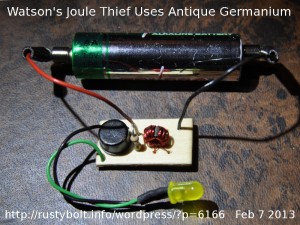I have read the claims of many Joule Thief fanatics who say that the JT will “suck the life out of dead batteries” and that’s how it got its name. But by the time the Joule Thief gets to a battery, isn’t it already mostly used up?
During the Xmas holidays and since then, I have been connecting dozens of AA cells up to Joule Thiefs and putting them on a shelf. I’ve run down these supposedly dead AA cells to well below a quarter of a volt, due to my use of germanium transistors in the JTs. I also use silicon JTs, but they can only run the AA cells down to 0.4 volts or so, leaving enough ‘juice’ in the battery to run the germanium JTs. But I have observed that the cells having less than a half volt when connected to germanium JTs have very little life left in them; they run for a short time before they drop to less than 0.2V. I’ve watched some die a minute or two after I connect them. I’ll admit that many of these dead cells have been lying around for quite awhile. But even the recently dead cells with around 1.3 volts last only a few days on the shelf, and even then, they quickly dim so that much of the JT’s light output is only in the first few hours, with much lower light output while dimming down later.
 Comparing these dead ones to a fresh cell is quite a difference. The fresh cell lasts a lot longer and the LED is at full brightness (see note). My point is that the almost dead cell has but a small fraction of its charge left, most of it being used up in the toy or camera from which it was discarded. I think that the JTers who tout how much life is left in these dead cells really haven’t looked at the overall scene. If they really want to get all the energy from those AA and AAA cells, they should do it with fresh ones, thereby saving the extra weight of carrying around a bunch of nearly dead cells.
Comparing these dead ones to a fresh cell is quite a difference. The fresh cell lasts a lot longer and the LED is at full brightness (see note). My point is that the almost dead cell has but a small fraction of its charge left, most of it being used up in the toy or camera from which it was discarded. I think that the JTers who tout how much life is left in these dead cells really haven’t looked at the overall scene. If they really want to get all the energy from those AA and AAA cells, they should do it with fresh ones, thereby saving the extra weight of carrying around a bunch of nearly dead cells.
I put some cardboard on the shelf before I put the JTs on the shelf. I have several blobs of dried battery juice on the cardboard, where the cells leaked and then dried. Without the cardboard I think the shelf would have had the paint damaged by the juice. One day I thought it would be a terrific idea to spread several dozen JTs out on the floor, each lit up by its own dying AA cell. Then I could claim the World Record for the number of Joule Thiefs running at one time. But then my sensibility took over and I remembered that I might damage the floor with battery juice, so I didn’t do it.
Back to juicing…
Note: One has to realize that the Joule Thief circuit has a difficult time driving the LED to full brightness (20 mA) from a fresh 1.5V cell. When the voltage drops as the cell dies, the JT has an even harder time to boost the voltage up to the LED’s 3.3V. This is why the LED dims so much as the cell dies. It is also why the cell takes so long to die: the current drain gets lower and lower as the voltage drops, which prolongs the slow cell death. When the cell is below 1V, the LED really begins to dim and soon is no longer able to furnish enough light to do any illumination. It just indicates that the circuit is still running. Just like the LED in the picture. The germanium Joule Thief is sucking the last few hundred millivolts out of a dead AA cell. The yellow LED is just barely glowing, hard to see when the lights are bright.
I think it is a good question. Even with a JT, at what voltage should you finally throw that cell into the now it is DEFINITELY for recycling pile? However, I have had many batteries which looked soon to be dead but seem to revive. My JTs turn off by day, they may be dim in the morning but by evening they seem to be revived. Personally, I have not had leakages (yet). Using magnetic claspers, one can easily put two cells in series. My JTs are tuned to draw about 20ma input from 1 cell at 1.2v, indeed they last for ages. There seems to be an endless supply of used batteries which do run them for many days. How can you resist testing and using those shiny new looking discards?